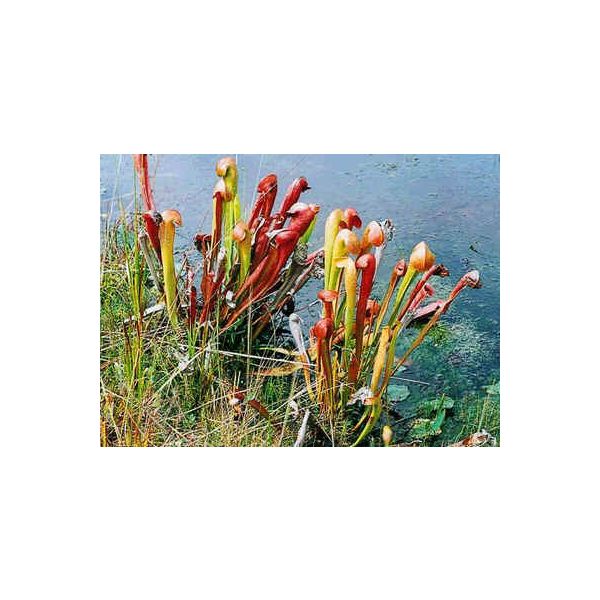Sarracenia Minor Okefenokee Giant Seeds (Hooded Pitchers, Sarracenia Minor Seeds)
Sarracenia Minor Okefenokee Giant Seeds (Hooded Pitchers, Sarracenia Minor Seeds)
They are best grown outdoors as container or potted plants. They are excellent for the sunny deck or patio. You may also grow them in a pond or fountain.
Availability: Out of stock
SKU
Sarracenia Minor Okefenokee Géant
Sarracenia minor okefenokee giant, the Hooded Pitchers, naturally grows in the Okefenokee Swamp in Southern Georgia. This is a giant form of Sarracenia Minor, one of the most ingenious American pitcher-plants, reputed to produce traps to 4' tall or more in nature, though cultivated plants are usually somewhat shorter. They are best grown outdoors as container or potted plants. They are excellent for the sunny deck or patio. You may also grow them in a pond or fountain.
The pitchers are predominantly green, becoming darker with age. Red venation is evident around the windows, is predominant on the underside of the hood, and pitchers develop a bronze hue when subjected to strong sunlight. Pitcher production ceases in Autumn though developed traps often remain throughout Winter.
This variety produces large yellow flowers in late Spring. They grow on stems that are shorter than the pitchers. Clip off old leaves to make way for flower buds and new leaf growth.
Hardiness zones 8-9, (-10øC/15øF,-5øC/25øF) in Winter. This variety does best growing in areas where the growing season is long and the Winters are very mild, such as in central Florida. As Winter approaches, your Hooded Pitcher will slow down in growth. This is perfectly normal because Hooded Pitchers require 3-4 months of Winter dormancy. Preferably a Winter minimum of 40øF. As container plants, they and can survive temperatures down to 20øF for brief periods of time during their dormancy. May be grown outdoors. If left outside during Winter, protect them from dry freezing wind during deep freezes by covering the plant with black plastic. Uncover the plant when the deep freeze and dry freezing wind is over.
Hooded Pitchers require nutrient-free soil that provides good drainage. Use a standard soil mixture of 50% peat moss and 50% perlite. Never use potting soil or fertilizer. Potting soil and fertilizer will kill your plant. Because of their specific soil requirement, avoid planting them directly in the ground unless you have created a specific type of bog garden.
Prefers as much light as possible, preferably somewhere sunny. During the growing season, grow your Hooded Pitcher outside in full sun, with a minimum of 6 hours of direct sunlight for vigorous growth. Shade from direct sun if kept in a greenhouse.
Keep the pot in standing water to keep the soil wet at all times. Never allow the soil to dry out completely. Water must be distilled or rain water because they do not tolerate city or hard water. It is a good idea to place a pie pan or large saucer, with about an inch of water in it, under the pot. Elevate the pot by placing pebbles under it so that the base of the pot is barely in contact with the water, not submerged; the growing medium must stay moist, but never soggy. This will keep the humidity around the plant higher and it will ensure that the plant has a constant source of moisture. If you are growing your Hooded Pitcher in a pond, keep the water level halfway on the pot. Avoid drowning the crown of the plant. During their dormancy, they won't require as much light or water. However, make sure their soil never dries out.
| Common name | Hooded Pitcher Plant |
|---|---|
| Species | Sarracenia minor |
| Cultivar | okefenokee giant |
| Germination | The seeds require 6 weeks cold stratification before sowing, directly on the surface of your moist but not soaked soil mix. Once it's time to take the seeds out of cold stratification, cover the top of the pot with clear plastic so the humidity will remain high, place them in an area with real nice strong light and keep the temperature around 21øC/70øF, 27øC/80øF. When you see some tiny plants starting to sprout, slowly open the top of the pot, a little each day, so that the new seedlings don't go into shock from the humidity being lowered too quickly. After cold stratification, germination usually occurs in 1 to 3 months, but it can take longer, depending on their degree of unbroken dormancy, don't give up. |
| Scarification / Stratification | It creates a cold and moist environment for the seeds. This will break their dormancy. Place the seeds on top of a prepared soil mix. The pot is then placed into a ziplock bag with approximately an inch of water on the bottom of the bag. Close the bag shut and place it into the salad crisper compartment of your refrigerator. Make sure to check the seeds often. If fungus or mold appears treat it with a fungicide. |
| Price View | Price Range |

